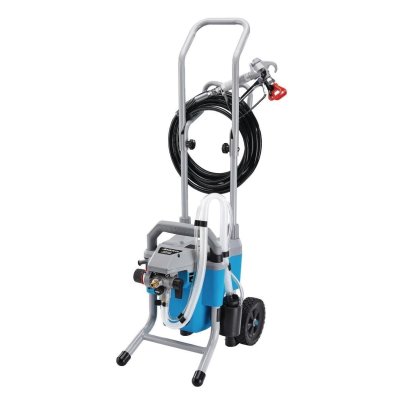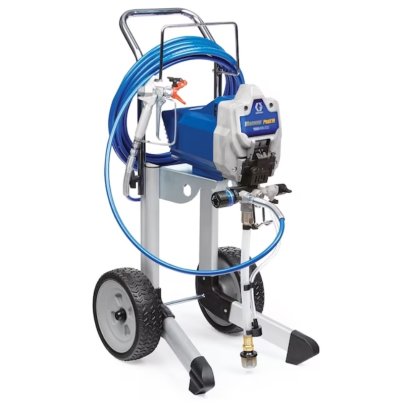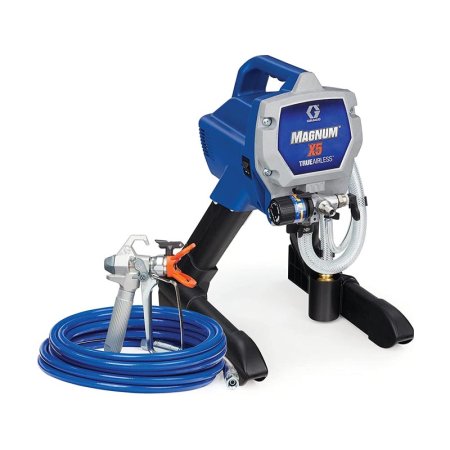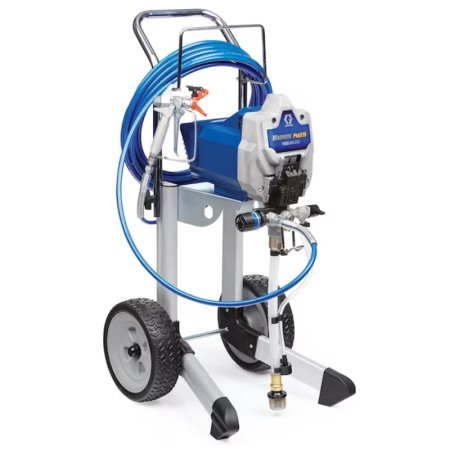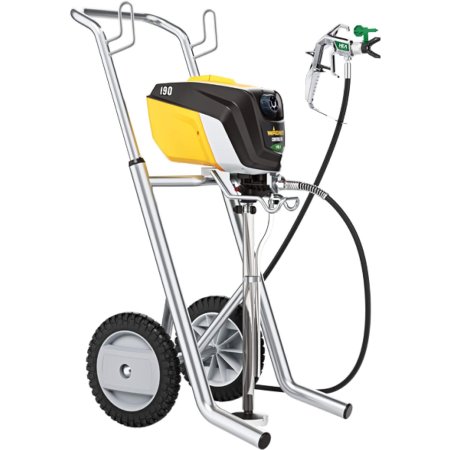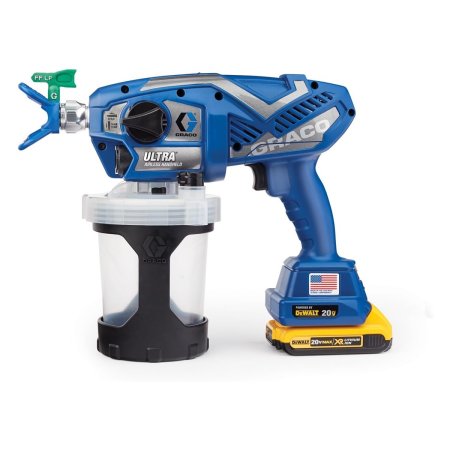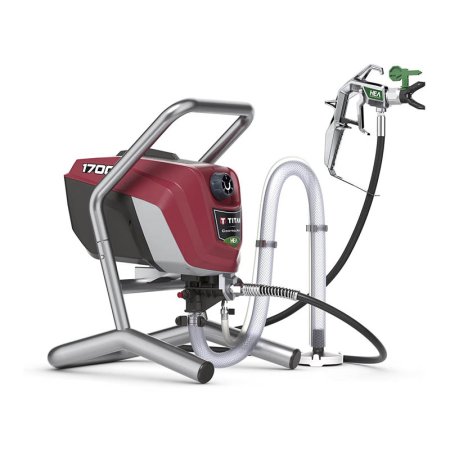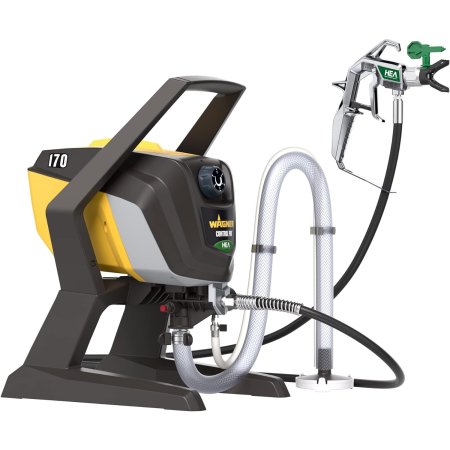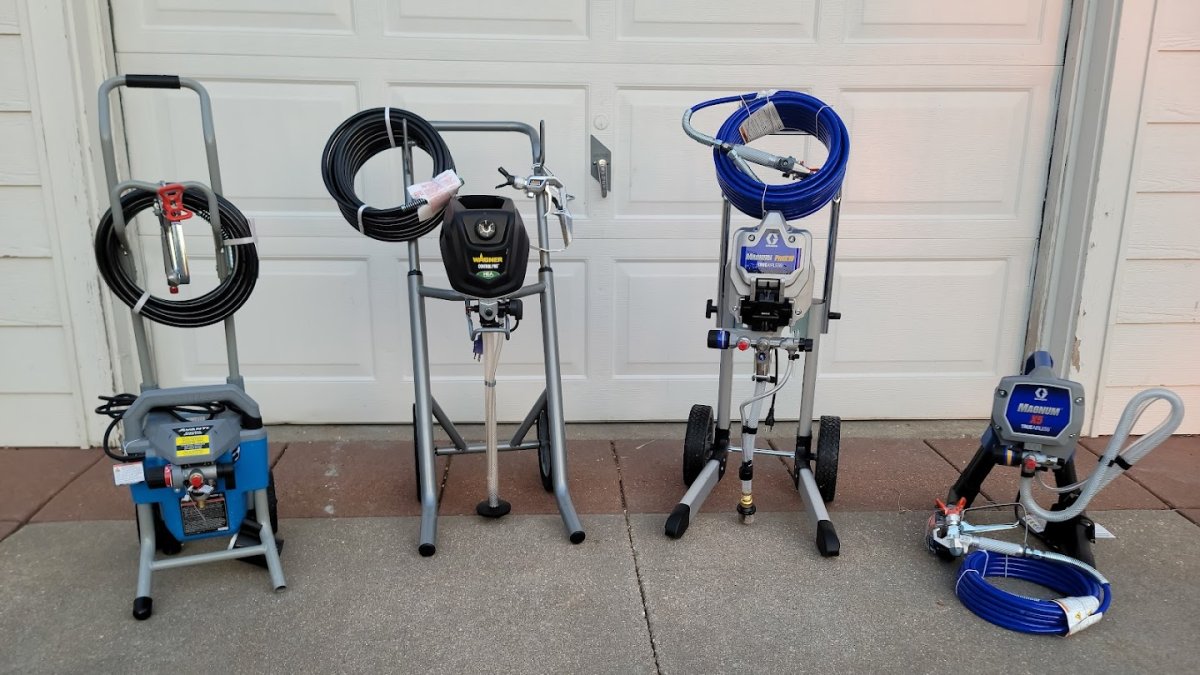
We may earn revenue from the products available on this page and participate in affiliate programs. Learn More ›
An airless paint sprayer is a finely tuned tool that uses a high-pressure pump to deliver a fine mist of paint for a high-quality finish. We researched more than 25 top-selling airless paint sprayers and selected four models for hands-on testing and painting in our homes and workshops. Of these four models, we found a favorite—the Graco Magnum X5 Electric TrueAirless Sprayer, a DIY-friendly sprayer that delivers professional results.
We also chose three additional airless sprayers based on build quality, brand reputation, and real-world consumer ratings. Keep reading to find out our impressions of the models we tested and learn what to look for when shopping for the best airless paint sprayer for your painting needs.
- BEST OVERALL: Graco Magnum X5 Electric TrueAirless Sprayer
↓ Jump to Review - BEST BANG FOR THE BUCK: Avanti Airless Paint, Primer & Stain Sprayer
↓ Jump to Review - BEST FOR PROS: Graco Magnum ProX19 Electric TrueAirless Sprayer
↓ Jump to Review - BEST FOR DIY: Wagner Control Pro 190 Sprayer
↓ Jump to Review - BEST BATTERY-POWERED: Graco Ultra Cordless Handheld Paint Sprayer
↓ Jump to Review - BEST FOR BEGINNERS: Titan ControlMax 1700 Sprayer
↓ Jump to Review - BEST FOR STAIN: Wagner Control Pro 170 Airless Sprayer
↓ Jump to Review
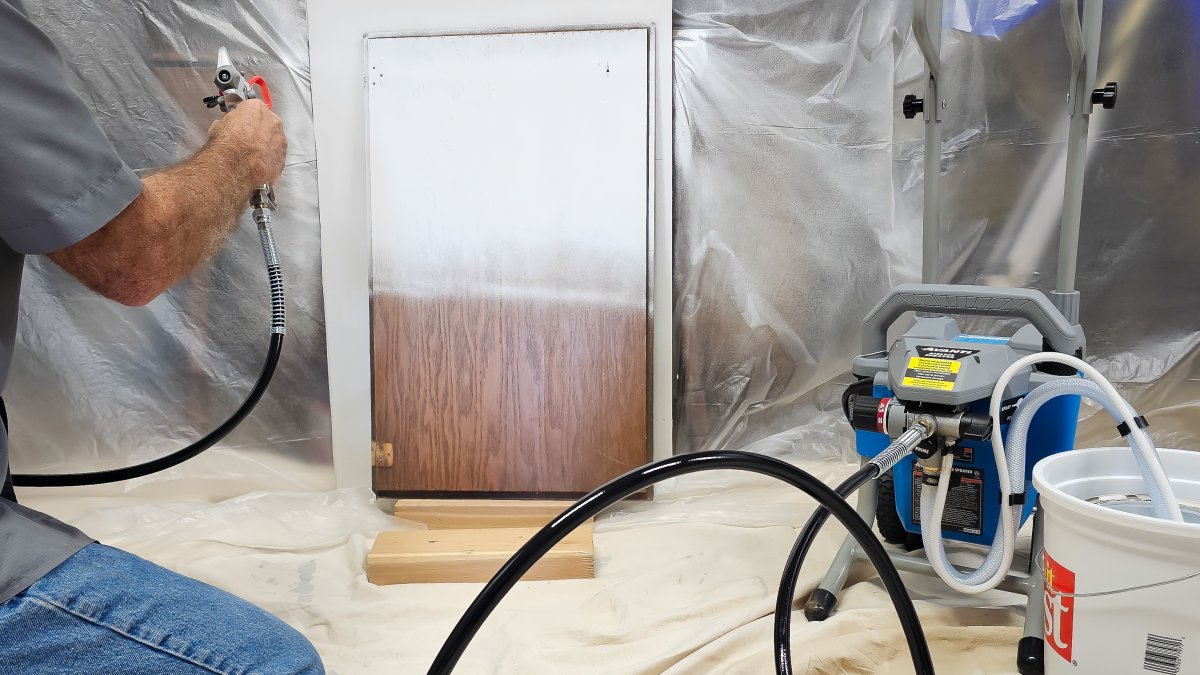
| Testing Stats | |
|---|---|
| Products tested | 4 |
| Time spent testing | 11 hours |
| Tests performed | 4 |
| Price range | $250 to $750 |
Our Top Picks
Each of the first four models in this guide excelled in our hands-on testing, and the subsequent three products offer features that meet our high standards for approval. Read on to discover the best airless paint sprayer for a professional-looking finish on all your painting products.This list includes some of the best airless paint sprayers for your home painting project.
Best Overall
Graco Magnum X5 Electric TrueAirless Sprayer
Product Specs
- Type: Corded electric
- Flow rate: 0.27 gallons per minute (GPM)
- Max pounds per square inch (PSI): 3,000
- Model: 262800
Our Ratings: Ease of Use 4.8/5; Performance 4.8/5; Cleanup 4/5; Value 5/5
What We Like
- Ability to fine-tune spray pressure
- Power-flush adapter speeds cleanup
- Delivers high-quality painted finish
What We Don’t Like
- No wrench included
- Only 1 spray tip in the kit
Graco dominates the paint sprayer industry with pro models that run well over $1,000, so we wanted to know if the DIY-friendly Graco Magnum X5 sprayer would give us a professional finish. This model did a fantastic job providing us with a flawless painted surface.
The Graco Magnum X5 is not a commercial machine—it includes a 25-foot hose and generates enough pump pressure to use a 75-foot hose (not included) but is not designed for use on large commercial projects. For that purpose, you’d want a more powerful sprayer, like the Graco Magnum ProX19 we feature below as Best for Pros.
This airless sprayer is an excellent option for most homeowner and DIY projects, including interior and exterior walls, siding, furniture, cabinets, and more. It comes almost completely assembled. We only had to connect the intake hose and the paint hose—the spray tip was already in the gun, and all the knobs and the stand were connected.
On startup, the Graco Magnum X5 automatically primed its pump within seconds, and then we got started. All it took was a slight turn of the pressure dial to achieve a fine paint spray that didn’t leave overlap marks. After testing this sprayer on several boards, plywood, and drywall, we used it to paint a client’s bifold doors, and the finish looked every bit as good as we’ve achieved in the past with professional paint sprayers. Make no mistake: You’ll need patience and practice to perfect the correct technique, but once you master it, you’ll get professional results from this spray paint machine.
Get the Graco Magnum X5 airless paint sprayer at Amazon, Lowe’s, Ace Hardware, or The Home Depot.
Best Bang For The Buck
Avanti Airless Paint, Primer & Stain Sprayer
Product Specs
- Type: Corded electric
- Flow rate: 3.1 GPM
- Max PSI: 3,000
- Model: AV-APS1
Our Ratings: Ease of Use 4.3/5; Performance 4/5; Cleanup 3.8/5; Value 4.5/5
What We Like
- Budget-friendly airless sprayer
- Adjustable pressure knob
- Easy assembly and included wrenches
- Powerful enough for a 150-foot hose
What We Don’t Like
- Lower spray gun quality but still adequate
Speed up your painting projects without spending a lot on an airless sprayer. Harbor Freight’s budget-friendly Avanti airless sprayer delivers up to 3.1 GPM at a maximum of 3,000 PSI, but it costs several hundred dollars less than some similar brands.
It took us about 10 minutes to assemble the Avanti sprayer: We had to attach the stabilizer legs, the extended handle, and the intake and paint hoses. However, the included wrenches simplify that process. The sprayer comes with a standard latex spray tip and a 25-foot hose, but the pump is powerful enough to handle a hose up to 150 feet.
Like the other models we tested, the Avanti airless sprayer automatically primed its pump when we turned the machine on. To start, we had a few paint splatters on our test board, but adjusting the pressure knob and rechecking resulted in a fine, uniform spray. This spray paint gun doesn’t quite feature the quality of the Graco sprayers in this guide, but it’s more than adequate for achieving a uniform paint finish on interior or exterior surfaces.
We found the Avanti sprayer provided the best finish when we used slightly thinned latex paint, which means it would likely be well suited for spraying stain when fitted with an appropriate tip.
Get the Avanti airless paint sprayer at Harbor Freight or Amazon.
Best For Pros
Graco Magnum ProX19 Electric TrueAirless Sprayer
Product Specs
- Type: Corded electric
- Flow rate: 0.38
- Max PSI: 3,000
- Model: 17G180
Our Ratings: Ease of Use 4.8/5; Performance 4.8/5; Cleaning 4/5; Value 5/5
What We Like
- High-quality spray gun
- Long hose capability
- Delivers a flawless finish
- Handles unthinned paint
What We Don’t Like
- Not suitable for elastomeric coatings
The Graco Magnum ProX19 airless sprayer is everything a professional painter or enthusiastic DIYer needs to paint large projects quickly. It includes an upgraded SG3 spray paint gun that features a swivel hose connector for better maneuverability. When we compared it to the spray guns included with the other models, the SG3 was clearly of higher quality.
This paint sprayer machine self-primed within seconds of turning on and delivered a fine, uniform spray from our first test forward. The Magnum ProX19 comes with a 50-foot hose, but its pump will accommodate a hose up to 150 feet. The longer hose capability means users can tackle larger projects without frequently moving the electric paint sprayer and the paint bucket.
The Graco Magnum ProX19 sprayer includes a standard 515 spray tip that is designed for latex paint, and it easily handles unthinned paint. The one downside of this sprayer is that it only works with up to a 0.019 spray tip. That is not uncommon, but in a pro-quality machine, we’d like to be able to spray elastomeric coatings, which requires a 0.025 tip. Still, this sprayer will easily handle most types of latex paint, primer, and stain—and provide a flawless finish.
Get the Graco Magnum ProX19 airless paint sprayer at Lowe’s, Ace Hardware, or The Home Depot.
Best For DIY
Wagner Control Pro 190 Sprayer
Product Specs
- Type: Corded electric
- Flow rate: 0.40 GPM
- Max PSI: 1,600
- Model: 580559
Our Ratings: Ease of Use 4.5/5; Performance 4.5/5; Cleanup 4/5; Value 4.5/5
What We Like
- Reduced overspray for detailed application
- High-quality paint finish
- Includes a 50-foot hose
What We Don’t Like
- Not designed for high-speed coverage
- Better with thinned materials
The Wagner Control Pro 190 airless paint sprayer was impressive in our testing. With a higher 0.40 GPM and a lower 1,600 PSI, it provided a uniform spray without the overspray associated with higher-pressure machines. We were able to make clean paint swaths without getting excess paint on surrounding surfaces.
This model includes a 50-foot hose that’s just right for reaching all the areas of most residential paint projects, along with a 515 latex tip. We got a slightly better finish from thinned latex, which suggests the sprayer will also easily handle stains when paired with the HEA 311 tip (sold separately).
The sprayer is not designed for projects that require high-speed coverage; however, it is well-suited for DIY projects that demand detailed paint application, such as painting doors and cabinets or applying stain and sealers.
Get the Wagner Control Pro 190 airless paint sprayer at Amazon or The Home Depot.
More Great Options
We didn’t test the following models, but they offer top-notch features and are highly recommended by users. Consider one of these options if you’re still searching for an airless paint sprayer.
Best Battery-Powered
Graco Ultra Cordless Handheld Paint Sprayer
Product Specs
- Type: Battery-operated paint sprayer
- Flow rate: Not listed
- Max PSI: 2,000
- Model: 17M363
What We Like
- Battery-powered cordless convenience
- Battery compatible with other DeWalt 20-volt (V) batteries
- Compact and portable
- Professional-quality finish
What We Don’t Like
- Not designed for high-speed coverage
No electrical outlet? That’s not a problem with the Graco Ultra cordless handheld paint sprayer. While most airless paint sprayers tend to be designed for use with heavy-duty extension cords, you can use this model in remote locations without an electrical power source. A DeWalt 20V MAX rechargeable battery (battery and charger included) powers this handheld sprayer, so if you’re a DeWalt fan like we are, you can swap in other 20V batteries, if desired.
This handheld paint sprayer is just the ticket for small paint jobs, such as painting furniture or shutters—or just quick touch-ups—and it’s ideal for painting in small rooms when lugging a larger sprayer would be impractical. While this isn’t a versatile sprayer that can handle all jobs, it’s a great add-on for a pro facing a small paint job or a DIYer who regularly tackles limited-sized projects.
Get the Graco Ultra airless paint sprayer at Amazon.
Best For Beginners
Titan ControlMax 1700 Sprayer
Product Specs
- Type: Corded electric
- Flow rate: 0.33 GPM
- Max PSI: 1,500
- Model: 0580009
What We Like
- High-efficiency airless (HEA) technology for reduced overspray
- Good for detailed work
- Versatile for stains and paint
- Durable all-metal spray gun
What We Don’t Like
- Not ideal for high-speed painting applications
The Titan ControlMax 1700 is an HEA paint sprayer, which means it produces less of the overspray that can be an issue when you’re getting comfortable with paint sprayers. The manufacturer claims the reduction in overspray is up to 55 percent, making this sprayer a great pick for beginners trying to master the techniques for a flawless finish.
A lower 1,500 PSI ensures it is easier to control the paint swaths while lessening the chance of making messes. We also like this model for painting details like intricate trim and shutter louvers. You’ll still need to tape off for clean edges.
The lower PSI should also make the Titan ControlMax 1700 a good airless sprayer for applying stains and sealants. We like the idea of its all-metal gun for added durability and the inclusion of a 30-foot hose. While this model isn’t the best choice for high-speed application, it’s a solid option for any user who wants professional painting results from an airless sprayer.
Get the Titan ControlMax 1700 airless paint sprayer at Amazon, Lowe’s, or The Home Depot.
Best For Stain
Wagner Control Pro 170 Airless Sprayer
Product Specs
- Type: Corded electric
- Flow rate: 0.33
- Max PSI: 1,500
- Model: 0580001
What We Like
- Lower PSI for applying stain
- Softer spray pattern
- Reduced risk of overspray
- Also handles paint
What We Don’t Like
- Not suitable for thick paints or high-speed applications
You can certainly spray paint with the Wagner Control Pro 170 sprayer, but with a maximum operating pressure of 1,500 PSI, it’s also well-suited to spraying wood stain, solid stain, and semitransparent stain.
We’re used to seeing lower operating pressures associated with softer spray patterns, which is ideal for applying stains that typically penetrate the surface of the wood rather than sit on top.
The lower PSI should also reduce the risk of overspray and make the Wagner Control Pro 170 easier to use when applying stain uniformly for even absorption. This sprayer includes a 30-foot hose and a 515 tip. If you plan on using this model exclusively for spraying stain, plan to invest in Wagner’s HEA 311 tip, which is better suited to spraying stain.
Get the Wagner Control Pro 170 airless paint sprayer at Amazon, Lowe’s, or The Home Depot.
Jump to Our Top Picks
How We Chose and Tested the Best Airless Paint Sprayers
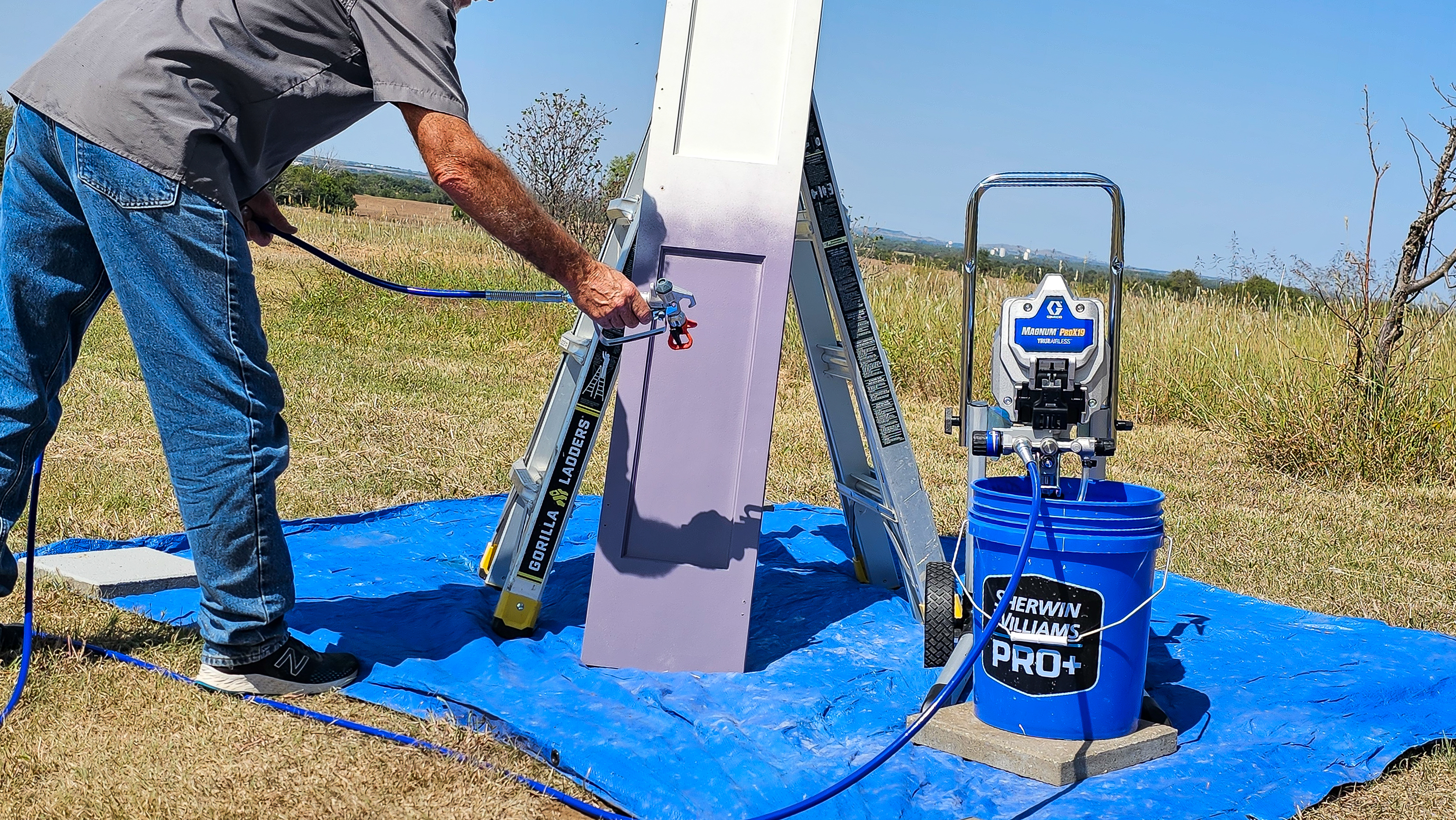
Airless paint sprayers reduce the time it takes to complete a small or large paint job, but they’re not all the same. We researched more than 25 airless paint sprayers and narrowed our selections to seven models that ranked well. We considered the brand—after all, Graco dominates the airless sprayer industry and has an excellent reputation for making high-quality rigs. Of the top seven sprayers, we tested four models that aligned well with various pro and DIY projects.
In hands-on testing, we assembled the sprayers and used them to paint drywall, boards, and plywood. We noted the build quality of the machines, and we paid special attention to the quality of the spray. We awarded points based on a rubric: The better a sprayer performed on a test or assessment, the more points we gave to it. After testing, we averaged the points and used them to determine our top pick and place the other models in the appropriate category.
What to Consider When Choosing an Airless Paint Sprayer
When choosing the best airless paint sprayer for your project, keep in mind several considerations, including power, accessories, and paint flow, the last of which is affected by the size of the spray tip, the paint hose, and the pressure created by the spray gun.
Corded vs. Cordless
- Corded airless paint sprayers have a larger following for a few reasons. First, more manufacturers offer these models. Additionally, many corded sprayers can pull paint directly from the can or bucket instead of from a paint canister you have to preload. A corded sprayer, however, will tether you to the nearest outlet. This can make hard-to-reach areas difficult to navigate. Some corded sprayers are stationary, while others sit on a wheeled cart.
- Cordless airless paint sprayers make easier work of smaller areas and don’t require proximity to a power outlet, but these products generally cost more than their corded counterparts. Keep in mind that cordless sprayers run on batteries, so you can only use one for so long before it needs a recharge. Relatively new to the market, they are currently available in just a few limited options. Note: Don’t confuse cordless airless paint sprayers with high-volume low-pressure (HVLP) sprayers, which can look very similar but operate on air pressure.
Adjustable Pressure
You can adjust the pressure on some airless paint sprayers. For example, you could set a sprayer at a higher pressure for larger jobs, like painting multiple walls in a room, so it coats the walls faster. For fine-detail paint jobs, like accents or baseboards, you could lower the pressure to better control the spray.
With adjustable pressure, the same airless paint sprayer can handle a wide variety of projects. You’ll just need to change the tip and filter to accommodate the various pressure settings without restricting the flow or clogging the nozzle.
Tip Size
The tip of an airless paint sprayer helps control the width and the speed of the spray. A larger tip works best with thicker viscosity fluids, while a tip that is too fine may clog during use. Some sprayers include a variety of tips, but many come with only one or two tips. A sprayer may also include a spray tip guard to prevent dried paint from clogging the sprayer. Depending on the types of jobs you tackle with your airless paint sprayer and how frequently you use it, plan to occasionally purchase new tips.
Tips begin at 0.009 inches and go up in size in increments of 0.002 inches. In general, smaller tips (0.009 inches to 0.013 inches) work best for stains and lacquers; medium tips (0.015 inches to 0.019 inches) work well for oil-based and latex paint; and larger tips (0.021 inches and above) should be reserved for very thick materials like heavy latex, elastomeric, and block filler.
Filters
Filters work with tips to ensure the right flow of paint comes through the nozzle. They also filter out junk and lumps in the paint so the tip and nozzle don’t clog. Clean the filter after every use to keep it functioning properly.
The finer the filter, the more time you’ll need to spend cleaning it and the more often you’ll need to replace it. Most airless paint sprayers come with a filter already installed, but you must replace this filter as it wears out to keep the sprayer performing as it should.
When choosing a filter, make sure that the size is appropriate for the application. If you are using a larger tip with high-pressure output, a fine filter will catch more debris and reduce clogs but also restrict the flow of paint. This mismatch could damage the filter as well.
On the other hand, a smaller tip with a larger filter will allow some lumps to pass through that may be too big for the smaller tip, resulting in clogs. Always match the tip and filter to the pressure setting to ensure a smooth flow.
Hose Length
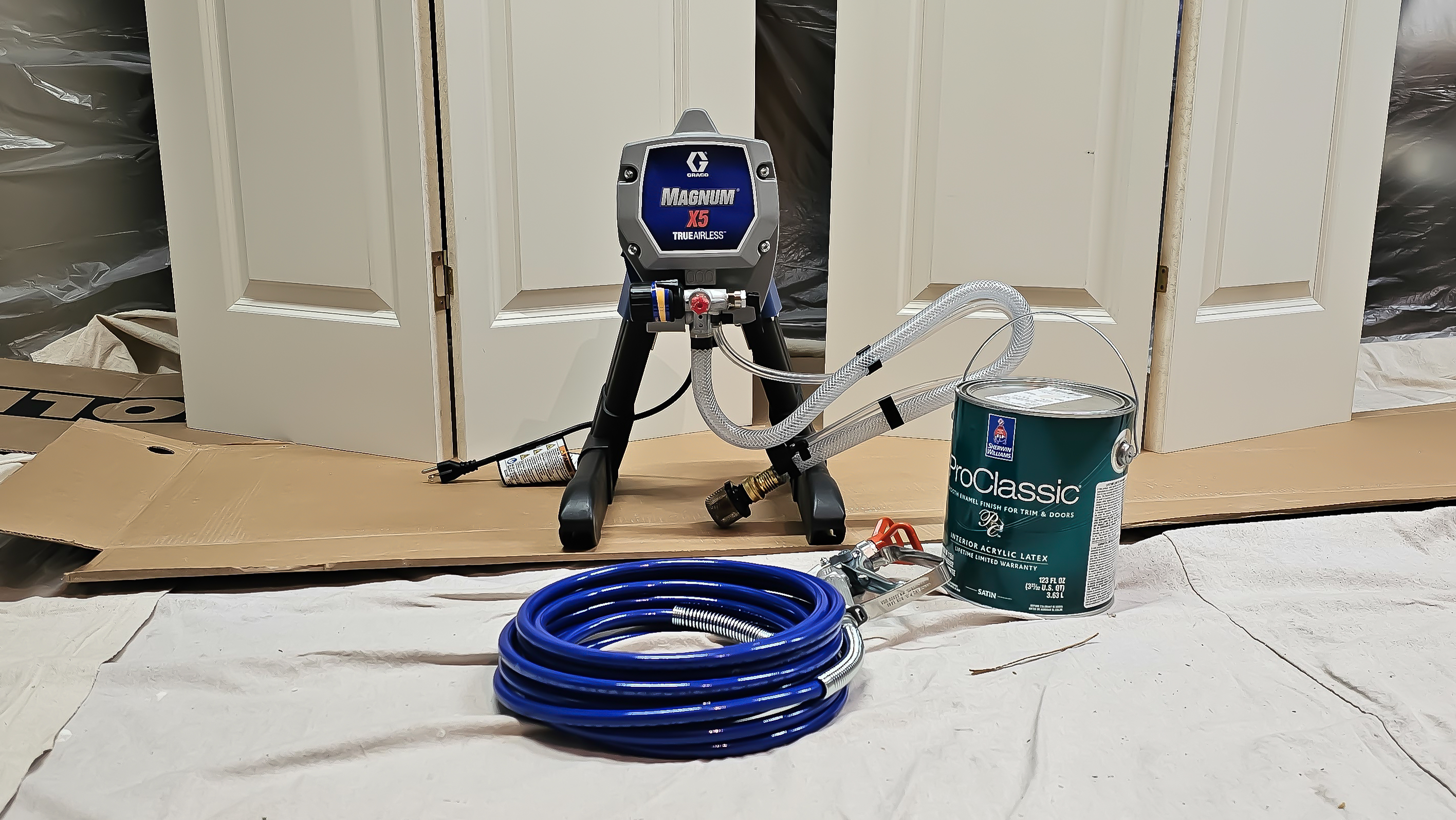
The length of the hose required for an airless paint sprayer depends on the project. A cordless paint sprayer will not have a hose, so you can move freely. Corded models require a hose, so ensure its length won’t restrict your movement so much that the sprayer isn’t useful.
There are no standard hose lengths for most airless paint sprayers. Just keep in mind that longer hoses require more power to properly pressurize the sprayer: A 100-foot-long hose won’t do much good on a small airless paint sprayer. If you need the flexibility of a long hose, select an airless paint sprayer that provides adequate power.
Flow Rate
The flow rate of the airless paint sprayer, typically expressed in GPM, is the amount of paint the sprayer can apply in a given time frame. The flow rate determines the maximum tip size you can use with the sprayer. The tip’s flow rate must be less than the maximum flow rate of the paint sprayer for the sprayer to function properly.
If the tip is too large, the sprayer will not be able to provide the amount of paint needed for an effective coat. But, for residential projects, this usually isn’t a problem since the scope of most home projects is too small to warrant using very large tips.
Size and Weight
The size and weight of an airless paint sprayer won’t change its overall performance, but it may still be of concern, depending on how you use the sprayer and your comfort with lifting heavy objects. Cordless airless paint sprayers are light, easy to hold, and incredibly mobile. Corded sprayers have a larger motor and may be more difficult to carry.
The heaviest sprayers work best with a long hose so they can remain in place. Some stationary airless paint sprayers come on a wheeled cart for use on a single floor. Always check the weight of any product to ensure you can handle it without risking injury.
Maximum Yearly Use
Consider the kinds of paint jobs you’re planning over the next year and make sure the maximum yearly use of the sprayer is up to the task. Airless paint sprayers have a maximum recommended yearly usage measured in gallons of paint used per year. For corded sprayers, this usage may range from 50 to 500 gallons. There are very few cordless sprayers on the market for comparison.
Tips for Using an Airless Paint Sprayer
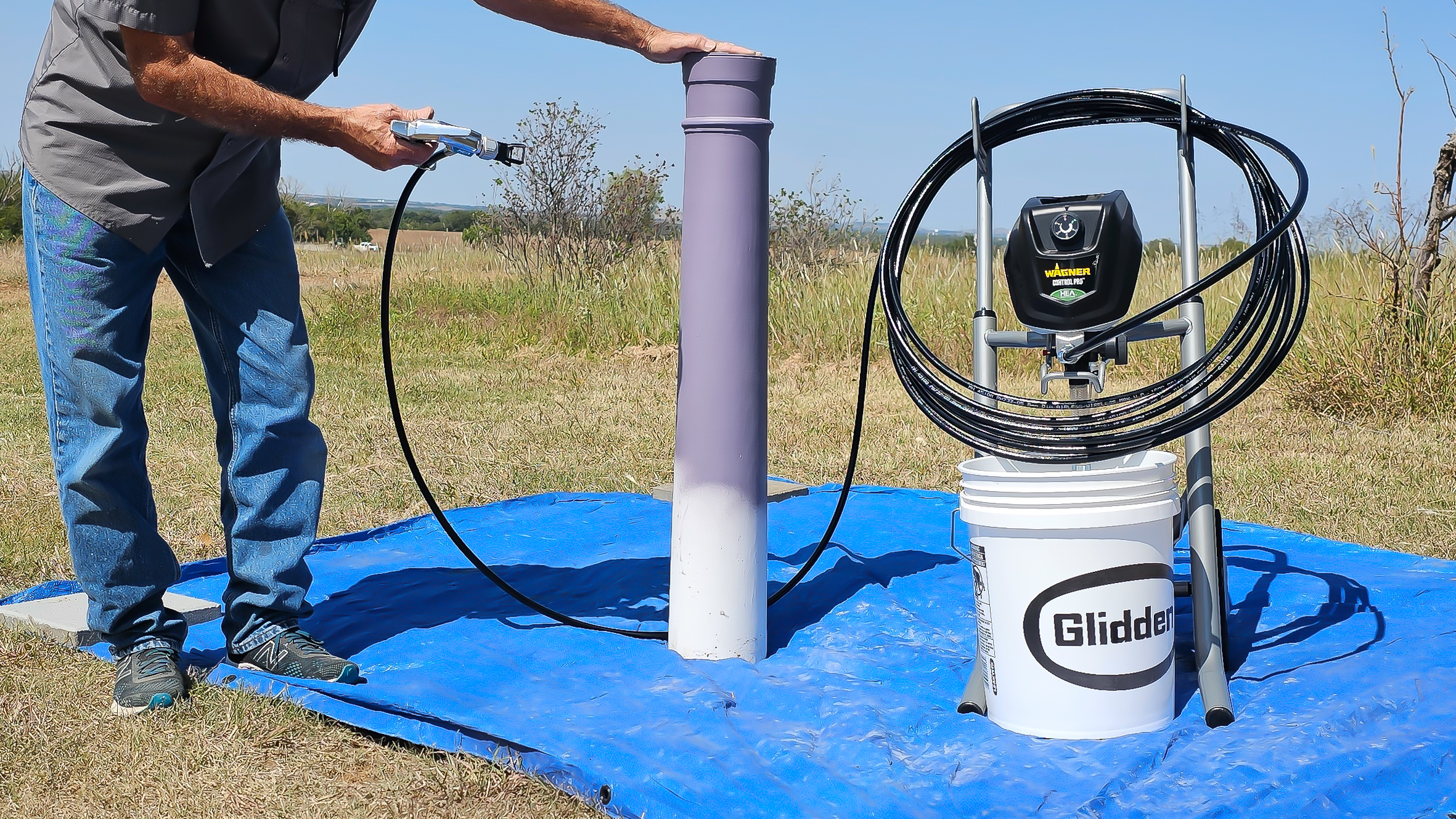
It’s important to consult manufacturer instructions when operating an airless paint sprayer, but in general, the process is as follows:
- Ensure you have the correct filter and nozzle for the paint application.
- Fill up the paint reservoir or guide the paint siphon hose into the paint bucket.
- Prime the airless sprayer by adjusting it to the prime setting (if it has one) and drawing paint up into the hose with the pump. Allow some paint to drip out of the end of the hose so you know the system is fully pressurized.
- Once paint is moving through the hose and into the sprayer, spray into a waste bucket to clear any air before beginning to paint your surface.
FAQs
Here are answers to some of the most commonly asked questions about airless paint sprayers.
Rolling paint is inexpensive, easy to set up, and relatively straightforward, making it the better choice for beginners. Spraying paint comes with a higher up-front cost, and users will want to take the time to set up the airless paint sprayer as well as cover any surfaces or items to make sure that airborne spray doesn’t accidentally paint the furniture or floor.
However, when a skilled individual uses a paint sprayer, the setup time dramatically decreases, and the actual paint job also takes less time than it would with a roller. Airless paint sprayers are great tools for more experienced tradespeople and DIYers.
Most airless paint sprayers use more paint than a roller or brush by about 30 percent. However, a skilled professional or DIYer will save a lot of time on paint projects with an airless paint sprayer, so the higher paint consumption is a fair trade for the time most people save.
It depends on the specific product. While a small paint sprayer typically requires thinned paint for proper use, some compact models have the power to use unthinned paint. Before purchasing a sprayer, check the manufacturer’s recommendations to determine whether it can handle full viscosity or thinned paint.
Filters last longer when you clean them after every use. It’s also important to clean the filter if the sprayer has been sitting unused for an extended period to remove any debris before you begin spraying.
1. Fill a bucket with water for latex paints or paint thinner for oil-based paints.
2. Remove the intake hose from the paint and put the hose into the bucket.
3. Add 2 cups of water or paint thinner to a second bucket.
4. Remove and place the spray tip guard, tip, and filter into the second bucket for cleaning.
5. Reassemble the airless paint sprayer without the guard, tip, and filter.
6. Prime the pump and pump water or paint thinner through the system.
7. Use the spray gun to release the cleaning fluid and to flush any remaining paint from the system.
8. When all parts are clean, reattach the spray tip guard, tip, and filter.
While these steps explain the basic cleaning method, always refer to the manufacturer’s recommendations for product-specific differences.
Meet the Tester
Glenda Taylor is a contractor, product tester, and writer focusing primarily on construction, DIY tools, and home appliances.
Additional research provided by Timothy Dale.

